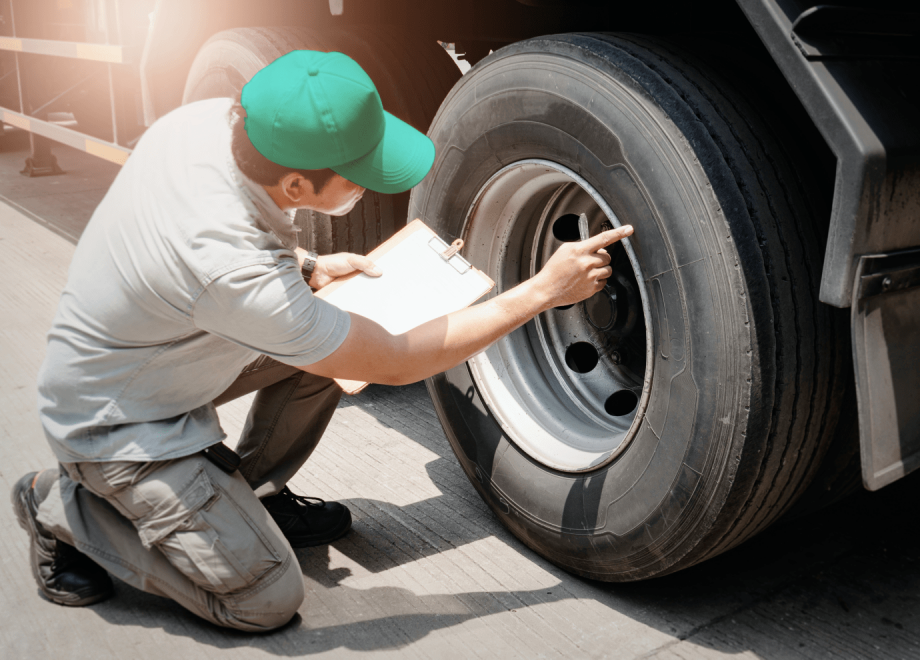
How can you keep your drivers safe on the road, reduce overhead costs for truck maintenance, and protect your business in the event of complaints or incidents? One of the most effective solutions to these problems is a pre-trip truck safety inspection, a mandatory procedure preceding each new trip.
Below, we will discuss this procedure in more detail, analyze the generally accepted levels of inspection, and also provide our truck inspection checklist that your company can use on a daily basis.
What Is a Pre-Trip Truck Inspection?
Pre-trip truck inspection involves a thorough check of structural elements, fuel, and other fluids, which together ensure the proper functioning of the trucks. Sometimes, it also requires the assessment of the driver’s condition and the legality of his or her work duties. The drivers have to carry out such checks daily before the start of their trips – i.e., before the vehicle begins to be used.
Even though transport companies often implement their own checklists to complete this procedure, there is a certain set of standards and rules that each must consider (for example, they can follow the Motor Carrier Safety Planner provided by FMCSA).
How Long Should a Pre-Trip Inspection Take?
Although there is no uniform standard regarding the length of inspections, this procedure should take 15-30 minutes on average. However, if any malfunctions and inconsistencies are discovered, the upper threshold for these time frames may increase.
What Are the Levels of a Truck Inspection?
The Commercial Vehicle Safety Alliance, a US non-profit organization, has introduced eight levels of vehicle inspection. After passing at least some of them (their list is selected based on the technical characteristics and type of use of a particular vehicle), drivers receive stickers that are valid for three months. The inspections themselves are carried out only by certified DOT employees. So, let's look briefly at these levels.
- NAS – it is a comprehensive level-one inspection of the driver and truck. Inspecting a truck involves a visual assessment of the serviceability of its internal systems and a check of documentation confirming the legal operation of a particular truck by a particular driver (this may include a driver's license, CDL permit, medical certificates, HOS, etc.). The driver's physical condition (the DOT officer checks whether the driver is under the influence of prohibited substances) and the legality and safety of securing the load are also assessed.
- Walk-Around Driver and Vehicle Inspection – it is similar to the level-one inspection but does not require a DOT officer to be present under the vehicle.
- Driver-Only Inspection – this type includes all the mandatory procedures of NAS but without the participation of the truck (that is, they are aimed at the driver only).
- A Special Check – it is an in-depth type of inspection addressed to a specific feature of a vehicle and is usually aimed at obtaining statistical data.
- Vehicle-Only Inspection – this type of inspection includes all the same procedures as the NAS but without the driver's participation.
- Enhanced NAS inspection – it is a standard inspection for trucks carrying radiological materials and equipment. It is performed under the supervision of representatives from the Department of Energy. After successfully passing it, the truck receives a special sticker with a radiation sign.
- Jurisdictional mandated inspection – it is a standard inspection for commercial vehicles such as school buses, taxis, limousines, and other vehicles used for the commercial transportation of people.
- NAS electronic inspection – it is an analog of offline inspection, which is performed by connecting inspectors via a wireless network to trucks that are on the road. During it, the driver transfers his or her personal data, current GPS coordinates, driving license, and other documents that are used during the offline NAS.
Why Truckers Should Always Perform a Pre-Trip Inspection
Since truck driving is one of the most dangerous jobs, providing truck driver safety to perform their daily tasks is essential. Actually, this is the main task of pre-trip inspections. At the same time, their regularity helps transport companies achieve some other advantages:
- Reduced maintenance costs. Regular inspections help drivers identify problems with their trucks early and fix them before they become serious and costly for your company;
- Ensuring the legality of your business. A procedure conducted by DOT officers determines the legality of a particular company's transportation operations. Specifically, representatives of the Ministry of Transport regularly check the reports of such inspections to ensure that if malfunctions and inconsistencies were discovered, they were also fixed in time;
- Correct determining the degree of the driver’s guilt for possible accidents. Yes, of course, this is not the most positive advantage, but given that accidents involving truck drivers still happen, it should not be discounted either. For example, if your driver was involved in an accident, having a report on the successful completion of a pre-trip inspection will help you prove that there is no your fault due to your truck’s malfunction.
Pre-Trip Inspection Checklist for Truckers
According to federal laws, any commercial vehicles are required to undergo regular pre-trip inspections. In addition, having documents confirming a successful inspection helps transport companies process claims with less damage to them. So, let's look at the key aspects of our commercial pre trip inspection checklist.
| Step | In Detail |
| Inspect the engine compartment | Start with examining the internal parts of the engine compartment, including the radiator, air compressor, tie rod, steering gear, belts, hoses, alternator, etc. |
| Inspect the fuel tank and battery | Next, you will need to inspect the fuel tank and battery – this way, you can make sure that nothing is leaking. Among other things, you should assess the battery charge level – it has to be enough to start the engine. |
| Inspect the fluids | Make sure there are no leaks under the truck. The same procedure must be performed under the hood – here, you can promptly identify problems inside the engine compartment. Also, check the condition of hoses, belts, and wiring, as well as assess the fluid level. |
| Inspect the brakes | Check the brake system of the track both out and in cab, making sure that it is adjusted correctly, the air lines are in good condition, and the thickness of the brake linings meets generally accepted standards. |
| Inspect the tires | Check whether the size of the tire treads is sufficient for their safe operation and also inspect the tires themselves for pressure, as well as the presence of holes, cuts, swelling, etc. In addition, make sure that there is no debris or stones in the wheels and that the tires fit disks snugly. |
| Inspect the wheel lug nuts | Make sure that the lug nuts are securely fastened to the wheels, and that there is no rust on their surface. |
| Inspect the coupling system | When inspecting the coupling system, you will need to check the integrity and reliability of all components that connect the trailer to the cab. Also, make sure that none of these components are missing. |
| Inspect the lights and reflectors | Check whether the reflectors are broken or faded due to wear or dirt on their surface. |
| Inspect the trailer | Try to identify mechanical defects that could interfere with the trailer’s attachment to the truck – usually, these are cracks and holes in the pins, bent hinges, etc. |
| Inspect the cabin | Go inside the cabin to inspect the serviceability of the seat belts, interior and exterior mirrors, seat, steering wheel, and pedals. Also, check the windshield for cracks and make sure the headlights, wipers, and turn signals work as intended. |
| Inspect the emergency kit | Finally, to complete your 15-minute pre-trip inspection, you need to clarify whether the truck has a set of emergency equipment, including a working fire extinguisher, bi-directional reflective triangles, red warning flags, etc. |
Drive Safe with Haulk
As we can see, truck inspection is a comprehensive process that requires special care and scrupulousness on the part of inspectors. To simplify it, you can use our TMS, which has functions for truck accounting, templates for documents about their condition, and a secure database of drivers. You can also download a PDF file with our CDL pre trip inspection checklist to implement it into your company’s work processes.








